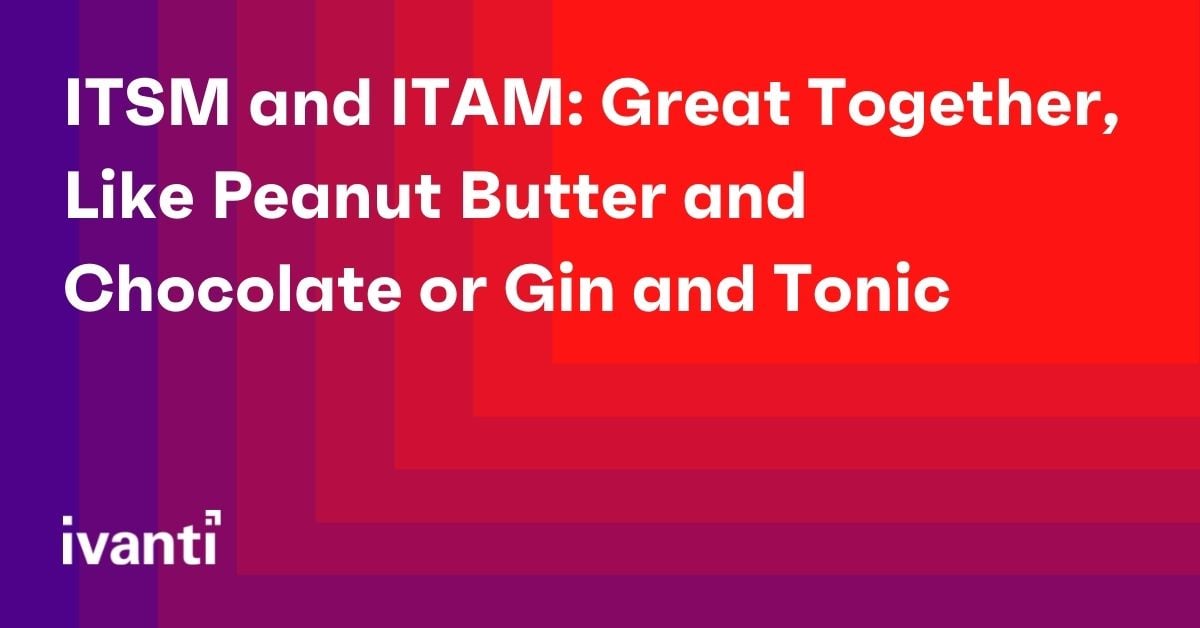ITSM and ITAM: Great Together, Like Peanut Butter and Chocolate or Gin and Tonic Pt. 1 of 2
Actor 1: “Hey, you got peanut butter on my chocolate.”
Actor 2: “Well you got chocolate in my peanut butter.”
This 1970’s ad campaign of “Two Great Tastes that Taste Great Together” put Reese’s Peanut Butter Cups on the map.
Know what else makes a great combo? IT Service Management (ITSM) and IT Asset Management (ITAM).
Historically Separate Disciplines
Traditionally detached disciplines, ITSM ensures timely delivery of essential services and support for the enterprise, while ITAM discovers and tracks the hardware and software assets for those services and optimizes the overall value, costs and compliance across the asset lifecycle.
These two practices are typically implemented in separate areas of the organization with different business objectives and goals, yet their processes and data are highly interrelated. When IT is structured along operational silos, gaining visibility and automating manual processes across the IT landscape becomes a real challenge. Separate teams, tools and objectives limit information and data sharing and isolate ITSM and ITAM from one another.
In contrast, ITSM and ITAM closely aligned and integrated means many activities and processes become more automated, efficient and responsive — with fewer things “falling through the cracks.” IT teams gain greater insight and are better positioned to implement more proactive practices that increase service levels and efficiency at lower cost.
Benefits of Combining ITSM and ITAM Processes: Five Use-Case Examples
This blog and its upcoming Part 2 companion post cover five use-case examples where combining ITSM and ITAM processes, data and insights can be part of an overall plan for IT to maximize operational efficiencies and improve service delivery, while also optimizing compliance and cost.
The first two use cases discussed below are: 1) Empowering Users with Self-Service; and 2) Faster, Better Incident Resolution. The Part #2 post covers the remaining three: 3) Tackle Problem Assets with Proactive Management; 4) Effective Change Management; and 5) Complete Lifecycle Visibility.
1. Empowering Users with Self-Service
IT service desks often lack the visibility into what software applications are available and how they’re being used. This hobbles the effort to fulfill self-service requests quickly, plus organizations end up purchasing more software, creating unnecessary spend and compliance issues. With unified ITSM and ITAM processes, you can reclaim or re-harvest unused software to cut costs and optimize existing asset performance.
For example, let’s say Jane, a sales manager, needs Microsoft Visio but doesn’t have the application and can’t afford to lose several days waiting for the purchase and installation of the software:
- She tries to launch Visio, but access is denied
- Traditionally, she would call the service desk to make the request
- The support desk analyst would send a task to the purchasing department, which would order a new software license after waiting to get approval for the purchase
- IT would send a confirmation to Jane
- The IT technician would perform a manual lookup of the device and the user and initiate the Microsoft Visio installation — now several days after the initial request.
Let’s now assume ITSM and ITAM are working together, accelerating software-request processes for users via self-service:
- When Jane submits her request for Microsoft Visio, the system checks and identifies that Visio licenses are available, yet unused
- The Visio application can then be assigned to Jane, and through endpoint management processes, installed automatically in compliance with entitlement
- The service management solution documents and tracks the process, notifies Jane and closes the software request
The whole process finishes in minutes instead of days, empowering users and freeing the service desk to focus on other strategic projects.
2. Faster, Better Incident Resolution
Businesses stay productive and employees stay satisfied when the Service Desk can resolve incidents more quickly and effectively. Consider Michael, an employee who contacts the Service Desk because his laptop doesn’t charge or shut down properly:
- If the Service Desk has visibility into the complete asset record of the laptop, they can see it was acquired only a few months earlier and is still under warranty
- With this asset visibility, the analyst handling the incident can choose to do a warranty replacement rather than spend resources trying to fix the laptop internally
- The analyst can also check the asset repository for an available loaner or replacement laptop so Michael can keep working
- When the faulty laptop is returned, any software licenses associated with the device can be reclaimed for re-use by other employees
This simple laptop example shows how the business could benefit from leveraging asset information for faster resolution times, increased employee satisfaction and lower support costs without sacrificing quality. With greater hardware and software information, analysts can more quickly identify possible causes for other types of common incidents, such as lower performance or application crashes, which could be due to insufficient RAM or conflicting software versions. Plus, logging all the steps and actions assists in analysis or in audit requirements later on.
Learn More in the Companion Blog
You’ll find three more use-case instances of how ITSM and ITAM are better together in Part 2 coming soon.
Catch Our Webinar Replay
Check out our recorded webinar Why IT Service & Asset Management Are Better Together. Our presenters share insights for solving business problems proactively with ITSM and ITAM. You’ll also hear interesting true stories such as what a cookie monster has to do with potential IT security threats.


